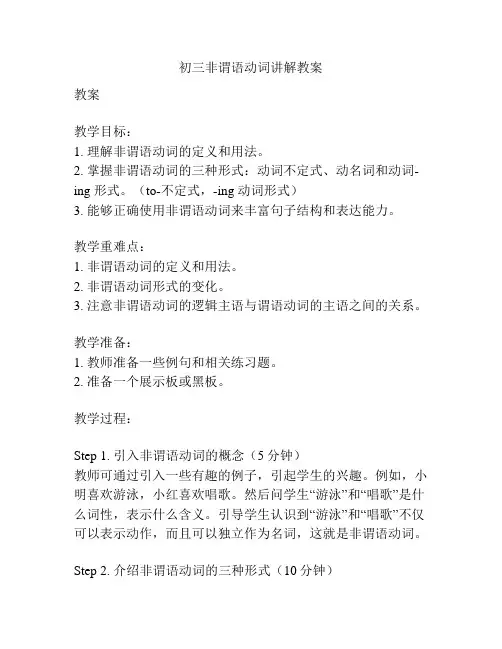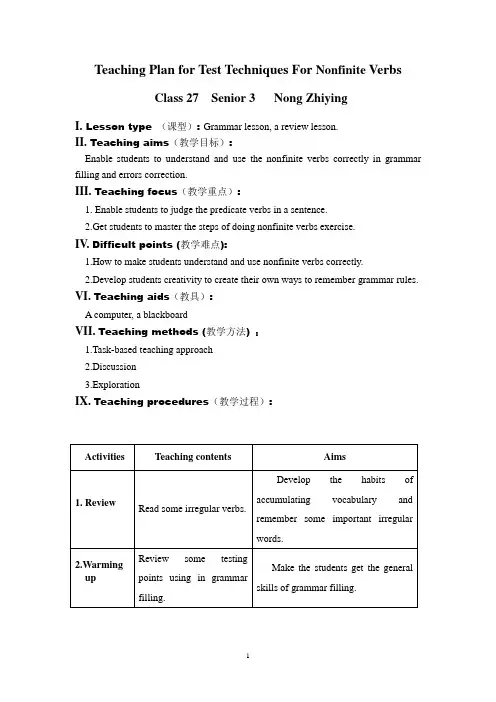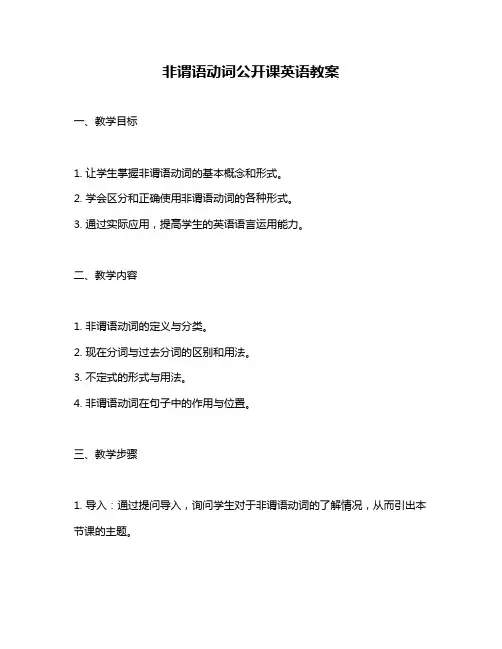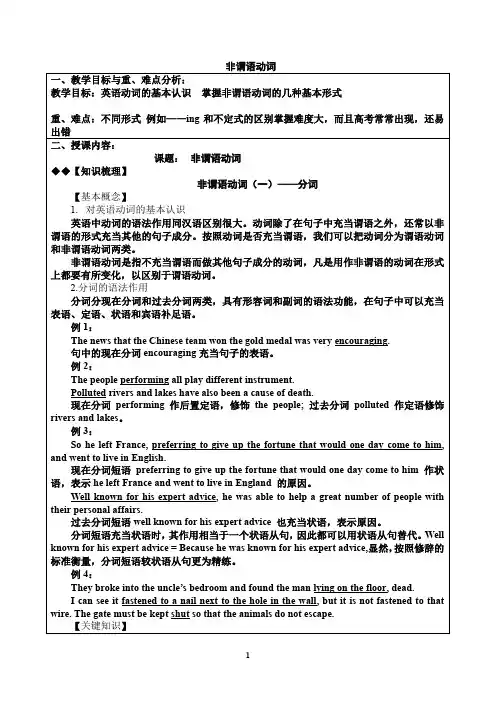非谓语动词公开课教案
完整版非谓语动词教案

目录•非谓语动词概述•不定式的用法与功能•动名词的用法与功能•分词的用法与功能•独立主格结构的用法与功能•非谓语动词的注意事项与误区非谓语动词概述定义与作用定义非谓语动词是指在句子中不充当谓语的动词形式。
它们不受主语的人称和数的限制,具有其他词类的特征,可以充当句子的其他成分。
作用非谓语动词能够丰富句子的表达,使句子结构更加紧凑、简洁。
它们可以表示动作、状态、目的、原因等多种语义关系,增加句子的层次感和表达的准确性。
0102 03形式区别非谓语动词有不定式、动名词和分词三种形式,而谓语动词则根据时态、语态、语气等有不同的形式变化。
功能区别非谓语动词在句子中不能单独作谓语,但可以充当主语、宾语、表语、定语、状语等。
而谓语动词是句子的核心,表示主语的动作或状态。
语义区别非谓语动词可以表示动作的过程、结果、目的等,而谓语动词则主要表示动作或状态本身。
非谓语动词与谓语动词的区别非谓语动词的形式与分类不定式由“to + 动词原形”构成,表示动作的过程或目的。
如:to go, to study 等。
动名词由动词+ing构成,表示动作的过程或状态。
如:walking, studying等。
动名词具有名词的性质,可以充当句子的主语、宾语等。
分词包括现在分词和过去分词两种形式。
现在分词由动词+ing构成,表示主动的动作或状态;过去分词由动词+ed构成(不规则动词有特殊的过去分词形式),表示被动的动作或状态。
分词可以充当句子的定语、状语等。
不定式的用法与功能to + 动词原形,如“to do”。
not to + 动词原形,如“not to do”。
to be + 现在分词,表示正在进行的动作,如“to be doing”。
to have + 过去分词,表示动作已经完成,如“to have done”。
基本形式否定形式进行时形式完成时形式不定式的构成与形式表语不定式短语可以作表语,说明主语的性质、特征或状态,如“My job is to teach English.”。
06433_完整版中的非谓语动词讲课教案

03
非谓语动词之不定式
2024/1/26
12
不定式的构成与性质
2024/1/26
不定式的构成
由“to + 动词原形”构成,否定形式为“not to + 动词原形 ”。
不定式的性质
具有名词、形容词和副词的特征,在句子中可以充当主语、 宾语、定语、状语等。
13
不定式作主语、宾语等用法
01 作主语
明。例如:I found him lying on the ground.(我发现他躺
在地上。)
22
分词独立主格结构及其用法
分词独立主格结构的构成
分词独立主格结构由名词或代词+分词构成,其中名词或代词与句子的主语不同,因此称为“独立主 格”。
分词独立主格结构的用法
分词独立主格结构在句子中作状语,表示时间、原因、条件等。例如:Weather permitting,we will go for a picnic tomorrow.(如果天气允许,我们明天将去野餐。)
不定式省略现象分析
2024/1/26
承前省略
当不定式与前文出现过的动词相同,且动作的执行者也为同一人或物时,可以省略不定式 中的动词及部分句子成分。例如:He likes to read books and (to) write stories in his free time.(他喜欢在空闲时间读书和写故事。)
good habit. (阅读是个好习惯。 )
作宾语
动名词可以作动词或介词的宾语 。例如:I enjoy listening to music. (我喜欢听音乐。)
作表语
动名词作表语时,表示主语的内 容或性质。例如:My hobby is collecting stamps. (我的爱好是
初三非谓语动词讲解教案

初三非谓语动词讲解教案教案教学目标:1. 理解非谓语动词的定义和用法。
2. 掌握非谓语动词的三种形式:动词不定式、动名词和动词-ing 形式。
(to-不定式,-ing 动词形式)3. 能够正确使用非谓语动词来丰富句子结构和表达能力。
教学重难点:1. 非谓语动词的定义和用法。
2. 非谓语动词形式的变化。
3. 注意非谓语动词的逻辑主语与谓语动词的主语之间的关系。
教学准备:1. 教师准备一些例句和相关练习题。
2. 准备一个展示板或黑板。
教学过程:Step 1. 引入非谓语动词的概念(5分钟)教师可通过引入一些有趣的例子,引起学生的兴趣。
例如,小明喜欢游泳,小红喜欢唱歌。
然后问学生“游泳”和“唱歌”是什么词性,表示什么含义。
引导学生认识到“游泳”和“唱歌”不仅可以表示动作,而且可以独立作为名词,这就是非谓语动词。
Step 2. 介绍非谓语动词的三种形式(10分钟)教师在黑板上写下以下三种形式:动词不定式(to-不定式)、动名词和动词-ing 形式,并给出相应的例子进行解释和说明。
动词不定式:动词原形前加“to”,表示动作的未完成、将要发生或被动作所致。
例:to swim, to eat。
动名词:动词的现在分词形式,可以作主语、宾语、表语、定语、宾补等。
例:swimming, eating。
动词-ing 形式:动词的现在分词形式,常作主语、宾语、定语、表语等,表示正在进行的动作。
例:swimming, eating。
Step 3. 练习非谓语动词的形式变化(20分钟)教师给学生一些练习题,要求学生用适当的非谓语动词形式填空,以巩固所学知识。
1. I enjoy _____________ (read) novels.2. She likes _____________ (watch) movies with her friends.3. They are good at _____________ (swim).4. He wants _____________ (go) to the park tomorrow.5. We need _____________ (finish) our homework before dinner.Step 4. 注意非谓语动词的逻辑主语与谓语动词的主语之间的关系。
(完整版)非谓语动词公开课教案

3.Examples&
explanation
Present fournonfinite verbsentencesand explain them.
Guide students to get some techniquesand stepsinnonfinite verbexercise.
Master some skills on correctingthe verb errors.
8.Reading
Read some structures and keep them in mind.
Remembersome important structures.
9.Homework
1.Review whatyouhave learned in the lesson.
1.How to make students understand and use nonfinite verbscorrectly.
2.Develop students creativity to create their own ways to remember grammar rules.
VI.Teaching aids(教具):
Teaching Plan for
I.Lesson type(课型):Grammar lesson,areviewlesson.
II.Teachingaims(教学目标):
Enable studentsto understand and use the nonfinite verbscorrectlyin grammar filling and errors correction.
非谓语动词公开课英语教案

非谓语动词公开课英语教案
一、教学目标
1. 让学生掌握非谓语动词的基本概念和形式。
2. 学会区分和正确使用非谓语动词的各种形式。
3. 通过实际应用,提高学生的英语语言运用能力。
二、教学内容
1. 非谓语动词的定义与分类。
2. 现在分词与过去分词的区别和用法。
3. 不定式的形式与用法。
4. 非谓语动词在句子中的作用与位置。
三、教学步骤
1. 导入:通过提问导入,询问学生对于非谓语动词的了解情况,从而引出本节课的主题。
2. 定义讲解:介绍非谓语动词的基本概念,强调其作为句子中非谓语成分的存在,并区分其与谓语动词的不同。
3. 形式分类:详细讲解现在分词、过去分词和不定式的形式变化,让学生了解其基本构成。
4. 用法讲解:通过例句分析,让学生了解非谓语动词在句子中的用法,并学会区分现在分词、过去分词和不定式的不同用法。
5. 练习巩固:通过填空、选择、翻译等多种形式的练习,让学生实际操作,加深对非谓语动词的理解和记忆。
6. 总结回顾:对本节课所学内容进行总结,强调非谓语动词的重要性和在实际运用中的技巧。
7. 布置作业:要求学生收集相关的非谓语动词例句,并进行分类整理,加深对非谓语动词的理解。
四、教学反思
本节课通过系统的讲解和丰富的练习,使学生对非谓语动词有了较为全面的了解,但在实际运用中仍需加强练习,提高学生的语言运用能力。
在今后的教学中,应更加注重实际应用,让学生更好地掌握英语语言的运用技巧。
非谓语动词教案

非谓语动词一、教学目标与重、难点分析:教学目标:英语动词的基本认识掌握非谓语动词的几种基本形式重、难点:不同形式例如——ing和不定式的区别掌握难度大,而且高考常常出现,还易出错二、授课内容:课题:非谓语动词◆◆【知识梳理】非谓语动词(一)——分词【基本概念】1.对英语动词的基本认识英语中动词的语法作用同汉语区别很大。
动词除了在句子中充当谓语之外,还常以非谓语的形式充当其他的句子成分。
按照动词是否充当谓语,我们可以把动词分为谓语动词和非谓语动词两类。
非谓语动词是指不充当谓语而做其他句子成分的动词,凡是用作非谓语的动词在形式上都要有所变化,以区别于谓语动词。
2.分词的语法作用分词分现在分词和过去分词两类,具有形容词和副词的语法功能,在句子中可以充当表语、定语、状语和宾语补足语。
例1:The news that the Chinese team won the gold medal was very encouraging.句中的现在分词encouraging充当句子的表语。
例2:The people performing all play different instrument.Polluted rivers and lakes have also been a cause of death.现在分词performing作后置定语,修饰the people; 过去分词polluted作定语修饰rivers and lakes。
例3:So he left France, preferring to give up the fortune that would one day come to him, and went to live in English.现在分词短语preferring to give up the fortune that would one day come to him 作状语,表示he left France and went to live in England 的原因。
非谓语动词公开课教案
非谓语动词公开课教案范文大全> 好词> :非谓语动词公开课教案以下是非谓语动词公开课教案的正文:第一篇:《非谓语动词在语法填空的运用公开课教案》Topic :the Uses of Non-finite Verb in the NMET2011.12.7Teaching goals: Knowledge aims:1. Have Ss master the base structures of non-finite verbs2. Enable Ss to solve problems in the passage through the methods Ability aims:1. have Ss master the ability to analyse the structure of the sentence2. have Ss use the proper forms of non-finite verbs in the passage . Emotional aims:1. Improve students' tactical awareness such as self-study, cooperation study and research consciousness Teaching key points:1. Use the proper form of non-finite verb such as V-ing ; V-ed; to do Teaching difficult points:1.Find out the logical subject, the proper voice the correct tense2.How to use the proper form of non-finite verbs Teaching methods:1. analyse the structure of the sentence and make sure the non-finite verb2. find out the logical subject and use the proper voice such as active voice ,passive voice3. use the correct tense of the non-finite verb in the sentenceTeaching procedures:Lead in : Three steps to go1.分析句子结构2.确定非谓语动词在句中的成分和作用3.确定时态五种基本句型为基础:Step1 .分析句子结构[例1] I got on the bus and found a seat near the back, and then I noticed a man front. (2011广东卷)[例2] He spit it out, (say) it was awful. (2010广东卷)归纳:[例3]The fact that so many people still smoke in public places _______ that we may need a nationwide campaign to raise awareness of the risks of smoking.A. suggestB. suggestsC. suggestedD. suggesting [例3].用turn 的正确形式填空1. If you2.3.[例1] She wished that he was as easy (please)as her mother,who was always delighted with perfume.(2009广东卷)[例3] 用see 的正确形式填空(1)_______ from the top of the hill, our houselooks like a car. (2)_______ the dog came over, our friend ran away.(3)_______ from the top of a hill, and you’ll find the city more beautiful. (4)_______ more clearly, they came up and got close to it. (see) [例4] 用compare的正确形式填空1. When____________different cultures, we often pay attention only to the differences without noticing the similarities.2.__________ with other top students, you are better.Strp3.确定时间状态[例1] 用discuss的正确形式填空(1)The question _________________now at the meeting is very important. (2)The question at the meeting last week is very important.非谓语动词公开课教案(3)The question __________________ at the meeting next week is very important. (discuss) [例2]1._____many times , but he still couldn't understand it .2. _____many times , he still couldn't understand it . A. Having been told B. ToldC. He was toldD. To be told 再比较:1.He is the best one______( do) the job.2.He was considered the first man _______________( invent)the telephone.Step 4 :其他常见的用法[例1].I haven’t decided which hotel (stay)归纳:[例2]1. (lose)in thought, he almost ran into the car in front of him.2. (tire)of playing football, he went back to the classroom.3. (face)with difficulty, he rushed forward bravely. 有些过去分词源于系表结果,分词已经形容词化,相当于形容词:非谓语动词公开课教案[例3]非谓语动词公开课教案1. I woke early only find)it was still midnight.2.The output of iron decreased by 23%last year, reach)80,000 tons.归纳:[例4]1. The flowers smell)sweet in the garden attractthe visitors to the beauty of nature. Step5: 考点综合应用语篇填空,用所给动词的适当形式填空。
2024非谓语动词公开课教案
01课程介绍与目标Chapter公开课背景提高学生英语语法水平适应英语教学改革需求随着英语教学改革的深入,对非谓语动词的教学提出了更高的要求,本次公开课旨在探讨更有效的教学方法。
知识目标能力目标情感目标030201教学目标与要求教学内容与方法教学内容教学方法02非谓语动词基本概念Chapter定义及作用定义作用种类与形式动名词不定式由动词+ing的动作或状态,具有名词的性质。
分词与谓语动词的区别与联系区别联系03非谓语动词用法详解Chapter不定式(Infinitive)定义用法例子动名词(Gerund)定义动名词是动词的一种非谓语形式,具有名词的性质,可以在句子中充当主语、宾语等。
用法动名词表示一种抽象的行为或动作,常用于固定搭配和某些动词后。
例子I enjoy listening to music.(我喜欢听音乐)中的“listening”为动名词作宾语。
分词(Participle)定义用法例子04非谓语动词在句子中的位置和功能Chapter句首01句中02句尾03作主语非谓语动词可以作句子的主语,表示一个动作或状态。
例如,“To see is to believe.”(眼见为实。
)非谓语动词可以作句子的宾语,通常跟在动词后面。
例如,“I want to learnhow to cook.”(我想学习如何烹饪。
)非谓语动词可以作句子的表语,描述主语的状态或特征。
例如,“Themovie is exciting towatch.”(这部电影看起来很刺激。
)非谓语动词可以作句子的定语,修饰名词或代词。
例如,“The singingbird is very beautiful.”(唱歌的鸟儿非常美丽。
)非谓语动词可以作句子的状语,表示动作发生的时间、条件、原因等。
例如,“Having finished hiswork, he went home.”(完成工作后,他回家了。
)作宾语作定语作状语作表语与主语的关系非谓语动词与句子主语的关系可以是主动或被动。
非谓语动词公开课教案
非谓语动词公开课教案第一章:非谓语动词概述1.1 非谓语动词的定义非谓语动词是指在句子中不充当谓语成分的动词形式。
非谓语动词包括动名词、分词、不定式三种形式。
1.2 非谓语动词的作用非谓语动词在句子中可以作为主语、宾语、定语、状语等成分。
非谓语动词可以用来表示动作的进行、结果、目的、原因等。
第二章:动名词2.1 动名词的构成动名词由动词的现在分词形式加上-ing构成。
规则动词的动名词形式直接在动词后加-ing,如:work →working。
不规则动词的动名词形式需要单独记忆,如:go →going。
2.2 动名词的用法动名词作主语,如:Working is important.动名词作宾语,如:I enjoy reading.动名词作定语,如:The book you gave me is very interesting.动名词作状语,如:Working hard, he achieved his goal.第三章:分词3.1 分词的分类分词分为现在分词和过去分词两种形式。
现在分词表示主动和进行,如:reading, writing。
过去分词表示被动和完成,如:written, cleaned。
3.2 分词的用法分词作主语,如:Reading is my hob.分词作宾语,如:I enjoy watching movies.分词作定语,如:The girl sitting next to me is my sister.分词作状语,如:Walking in the park, I saw a beautiful bird.第四章:不定式4.1 不定式的构成不定式由动词的现在分词形式加上-to构成,如:work →to work。
部分不规则动词的不定式形式需要单独记忆,如:go →to go。
4.2 不定式的用法不定式作主语,如:To learn English well is important.不定式作宾语,如:I want to watch a movie.不定式作定语,如:The book to read is on the table.不定式作状语,如:Going to the store, I bought some groceries. 第五章:非谓语动词的辨析与应用5.1 动名词、分词、不定式之间的区别与联系动名词表示一般性的动作或状态。
高中非谓语动词教案
高中非谓语动词教案【篇一:非谓语动词教案】(非谓语动词)period 1 infinitive(不定式)objectives1.to revise infinitive to get a better knowledge .2.to practice infinitive to grasp more .(非谓语动词——不定式、分词和动名词——在高中学习中是一个很重要的部分。
在每年的高考中,无论是全国卷还是省市卷都是必考部分,因此,对此部分的学习与掌握都是必要的。
考虑到其重要性以及内容较多,决定分部分进行全面复习,从基本概念入手,再从形式、功能、重难点等方面进行讲解,最后进行操练巩固,以达到复习的最佳效果。
) resources used grammar summary; the multimediai. revision and lead-in(复习与导入)show ss how important this part is.以2011年全国各省市高考卷中出现的非谓语导入。
ii. presentation(呈现)( on screen)归纳总结1 非谓语动词在句中所作的成分:归纳总结2 不定式的时态:不定式的语态(被动):归纳总结3 注意点:iii. practice(操练)高考链接1.(2011北京卷)25. it’s important for the figures _________ regularly.a. to be updatedb. to have been updatedc. to updated. to have updated2. (2011上海卷) 40. today we have chat rooms, text messaging, emailing… but we seem _____ the art of communicating face-to-face.a. losingb. to be losingc. to be lostd. having lost3. (2011浙江卷)19. if they win the final tonight, the team are going to tour around the city ______ by their enthusiastic supporters.a. being cheeredb. be cheeredc. to be cheeredd. were cheered4.(2011福建卷)27.the difference in thickness and weightfrom the earlier version makes the ipad 2 more comfortable____.a .held b. holding c. be held d. to hold5.(2011天津卷)7.passengers are permitted _____ only one piece of hand luggage onto the plane.a. to carryb. carryingc. to be carriedd. being carried6.(2011重庆卷)29.more tv programs, according to government to officials, will be produced _______people’s concern over food safety.a. to raiseb. raisingc. to have raisedd. having raised7 . (2011湖南卷)21 . the ability _____an idea is as important as the idea itself.a. expressingb. expressedc. to expressd. to be expressed8.(2011四川卷)11. simon made a big bamboo box _______ the little sick bird till it could fly. a. keep b. kept c. keeping d. to keep iv. language in use.(操练巩固—运用—提升)1.主语: 1.当今掌握一门外语真的很重要。
- 1、下载文档前请自行甄别文档内容的完整性,平台不提供额外的编辑、内容补充、找答案等附加服务。
- 2、"仅部分预览"的文档,不可在线预览部分如存在完整性等问题,可反馈申请退款(可完整预览的文档不适用该条件!)。
- 3、如文档侵犯您的权益,请联系客服反馈,我们会尽快为您处理(人工客服工作时间:9:00-18:30)。
I.Lesson type(课型):Grammar lesson,areviewlesson.
II.Teachingaims(教学目标):
Enable studentsto understand and use the nonfinite verbscorrectlyin grammar filling and errors correction.
2.Judge the relationship between the logical subjects and the verbs.
5.Discussion
Share their answers with partners and discuss why and why not.
Develop students learning habits and make students involve in class.
6.Sum up
Show the steps ofdoingnonfinite verbs exercises.
Get the steps of doingnonfinite verbs exercises.
7.Practice II
Correct the nonfinite verbs errors.
Aims
1. Review
Readsomeirregularverbs.
Developthe habits ofaccumulating vocabulary and remember some important irregular words.
2.Warming up
Reviewsometesting pointsusing in grammar filling.
Make the students get the generalskillsofgrammar filling.
3.Examples&
explanation
Present fournonfinite verbsentencesand explain them.
Guide students to get some techniquesand stepsinnonfinite verbexercise.
4.PracticeI& analysis
Finish the exercise and master the skills of doing this kind of exercise.
1.Make students judge the predicate verbs and nonfinite verbs in a sentence .
Acomputer,a blackboard
VII.Teachingmethods(教学方法):
1.Task-based teaching approach
2.Discussion
3.Exploration
IX.Teaching procedures(教学过程):
Activities
Teaching contents
2.Finish the exercises on Page 264fromQUAN YOU KETANG
Consolidate what the students have learned and develop the students’ability innonfinite verb.
III.Teaching focus(教学重点):
1.Enable students to judge the predicateverbsin a sentence.
2.Get students to master thestepsofdoingnonfinite verbsexercise.
IV.Difficult points(教学难点):
Master some skills on correctingthe verb errors.
8.Reading
Read some structures and keep them in mind.
Remembersoework
1.Review whatyouhave learned in the lesson.
1.How to make students understand and use nonfinite verbscorrectly.
2.Develop students creativity to create their own ways to remember grammar rules.
VI.Teaching aids(教具):
